Leaching Behaviour of Synthetic Leachate through a Sewage Sludge and Red Gypsum Composite as Intermediate Landfill Cover
Abstract
:1. Introduction
2. Materials and Methods
2.1. Synthetic Leachate
2.2. Composite Sample Preparation
2.3. Hydraulic Conductivity Using Column Test
2.4. Leachate Sample Analysis
2.4.1. PH
2.4.2. Chemical Oxygen Demand (COD)
2.4.3. Heavy Metals
2.5. Statistical Analysis
3. Results
3.1. Hydraulic Conductivity and Leachate Yield
3.2. Leachate Quality
3.2.1. PH, Heavy Metals and COD
3.3. Effects of Feed Solution on the Leaching Behaviour
3.4. Recommended Degree of Compaction
4. Conclusions
Author Contributions
Funding
Institutional Review Board Statement
Informed Consent Statement
Data Availability Statement
Acknowledgments
Conflicts of Interest
References
- Fuller, J.M. Landfill cap designs using geosynthetic clay liners. In Geosynthetic Clay Liners, Proceedings of the International Symposium, Nuremberg, Germany, 16–17 April 2002; CRC Press: London, UK, 2020; p. 129. [Google Scholar] [CrossRef]
- Zhang, D.; Wang, J.; Chen, C. Gas and liquid permeability in the variably saturated compacted loess used as an earthen final cover material in landfills. Waste Manag. 2020, 105, 49–60. [Google Scholar] [CrossRef] [PubMed]
- NSWEPA. Draft Environmental Guidelines: Solid Waste Landfills, 2nd ed.; NSW EPA: Sydney, Australia, 2015. [Google Scholar]
- Fan, X.; Zhu, W.; Qian, Y.; Wu, S.; Shu, S.; Lin, N. Increasing the Hydraulic Conductivity of Solidified Sewage Sludge for Use as Temporary Landfill Cover. Adv. Civ. Eng. 2019, 2019, 8163563. [Google Scholar] [CrossRef] [Green Version]
- Vinitha, V.N.; Latha, P.; Jaya, V. Permeability study of modified forms of sewage sludge suitable for temporary landfill cover material. In Recent Advances in Materials, Mechanics and Management, Proceedings of the 3rd International Conference on Materials, Mechanics and Management (IMMM 2017), Trivandrum, Kerala, India, 13–15 July 2017; CRC Press: London, UK, 2019; p. 183. [Google Scholar] [CrossRef]
- He, J.; Li, F.; Li, Y.; Cui, X.-L. Modified sewage sludge as temporary landfill cover material. Water Sci. Eng. 2015, 8, 257–262. [Google Scholar] [CrossRef] [Green Version]
- ILBS. Environmental Quality Act 1974 (Act 127), Regulations, Rules & Orders: Environmental Quality (Control of Pollution from Solid Waste Transfer Station and Landfill) Regulations 2009 (as at 10th June 2019); International Law Book Services: Kuala Lumpur, Malaysia, 2019. [Google Scholar]
- Zhang, P.; Zhang, G.; Wang, W. Ultrasonic treatment of biological sludge: Floc disintegration, cell lysis and inactivation. Bioresour. Technol. 2007, 98, 207–210. [Google Scholar] [CrossRef]
- Balkaya, M. Assessment of the geotechnical aspect of the use of paper mill sludge as landfill cover and bottom liner material. Desalination Water Treat. 2019, 172, 70–77. [Google Scholar] [CrossRef]
- Sharma, A.; Kaushik, M.K.; Naval, S. Present Status of MSW Disposal in Jalandhar and Suitability of Tire Derived Aggregates as a Drainage Material in Cover System of Landfill. J. Innov. Res. Sci. Eng. Technol. 2016, 5, 1111–1118. [Google Scholar] [CrossRef]
- Inazumi, S. Waste Sludge Barrier for Landfill Cover System. Doctoral Dissertation, Kyoto University, Kyoto, Japan, 2003. [Google Scholar] [CrossRef]
- Durak, S.G.; Özçoban, M.Ş.; Balcıoğlu, E.B.; Salmanli, Ö.M.; Demirkol, G.; Tüfekci, N. The Effect of Leachate on the Compacted and Consolidated Clay Soils. Eurasian J. Environ. Res. 2017, 1, 36–47. [Google Scholar]
- Dąbska, A. Hydraulic Conductivity of Compacted Lime-Softening Sludge Used as Landfill Liners. Water Air Soil Pollut. 2019, 230, 280. [Google Scholar] [CrossRef] [Green Version]
- Ozcoban, M.S.; Cetinkaya, N.; Celik, S.O.; Demirkol, G.T.; Cansiz, V.; Tufekci, N. Hydraulic conductivity and removal rate of compacted clays permeated with landfill leachate. Desalination Water Treat. 2013, 51, 6148–6157. [Google Scholar] [CrossRef]
- Edil, T.B.; Sandstrom, L.K.; Berthouex, P.M. Interaction of Inorganic Leachate with Compacted Pozzolanic Fly Ash. J. Geotech. Eng. 1992, 118, 1410–1430. [Google Scholar] [CrossRef]
- Safari, E. Preliminary Assessment of Proposed Soil Liner Compatibility with Leachate at New Landfill of Tehran. J. Biol. Sci. 2006, 6, 324–330. [Google Scholar] [CrossRef] [Green Version]
- Wang, G.; Gao, Y.; Tang, Y. Research on the mechanism for chemical clogging and its effect on the stability of tailing dam. Bulg. Chem. Commun. 2017, 49, 228–233. [Google Scholar]
- Francisca, F.M.; Glatstein, D.A. Long term hydraulic conductivity of compacted soils permeated with landfill leachate. Appl. Clay Sci. 2010, 49, 187–193. [Google Scholar] [CrossRef]
- VanGulck, J.F.; Rowe, R.K. Evolution of clog formation with time in columns permeated with synthetic landfill leachate. J. Contam. Hydrol. 2004, 75, 115–139. [Google Scholar] [CrossRef] [PubMed]
- Sunil, B.M.; Shrihari, S.; Nayak, S. Soil-leachate interaction and their effects on hydraulic conductivity and compaction characteristics. In Proceedings of the 12th International Conference on Computer Methods and Advances in Geomechanics, Goa, India, 1–6 October 2008; Volume 3, pp. 2380–2386. [Google Scholar]
- Ray, S.; Mishra, A.K.; Kalamdhad, A.S. Hydraulic performance, consolidation characteristics and shear strength analysis of bentonites in the presence of fly-ash, sewage sludge and paper-mill leachates for landfill application. J. Environ. Manag. 2022, 302, 113977. [Google Scholar] [CrossRef] [PubMed]
- Shang, K. Mechanical Characteristics and Micro-Mechanism of Modified Dredged Sludge Based on Calcium-Containing Solid Waste Used as Landfill Cover Materials. Processes 2022, 10, 451. [Google Scholar] [CrossRef]
- Rosli, N.A.; Aziz, H.A.; Selamat, M.R.; Lim, L.L.P.; Zawawi, M.H. Effect of compaction on physical properties of a sewage sludge and red gypsum mixture as intermediate landfill cover. Constr. Build. Mater. 2021, 289, 123153. [Google Scholar] [CrossRef]
- Zakaria, S.N.F.; Aziz, H.A. Characteristic of leachate at Alor Pongsu Landfill Site, Perak, Malaysia: A comparative study. IOP Conf. Ser. Earth Environ. Sci. 2018, 140, 012013. [Google Scholar] [CrossRef] [Green Version]
- Yong, Z.J. Papan Landfill Leachate Treatment Using a Sequencing Batch Reactor and Coagulation. Doctoral Dissertation, UTAR, Perak, Malaysia, 2017. [Google Scholar]
- Mohamad, M.; Abustan, I.; Samuding, K.; Mohamad, A.; Mohamad, N. Enhancement of Landfill Daily Cover in Minimizing the Migration of Heavy Metals in Landfill Leachate by Using Natural Soil, Pressmud Empty Fruit Bunch (EFB) in Pulau Burung Landfill. Int. J. Adv. Eng. Manag. Sci. 2017, 3, 37–47. [Google Scholar]
- Aziz, S.Q.; Aziz, H.A.; Yusoff, M.S.; Bashir, M.J.; Umar, M. Leachate characterization in semi-aerobic and anaerobic sanitary landfills: A comparative study. J. Environ. Manag. 2010, 91, 2608–2614. [Google Scholar] [CrossRef]
- Zerrouqi, Z.; Tazi, M.R.; Chafi, A.; Zerrouqi, A. Impact of Sewage Sludge Leaching on Soil Constituents and Quality. Environ. Res. Eng. Manag. 2020, 76, 87–96. [Google Scholar] [CrossRef]
- Geng, H.; Xu, Y.; Zheng, L.; Gong, H.; Dai, L.; Dai, X. An overview of removing heavy metals from sewage sludge: Achievements and perspectives. Environ. Pollut. 2020, 266, 115375. [Google Scholar] [CrossRef] [PubMed]
- Mohamed, B.A.; Ruan, R.; Bilal, M.; Khan, N.A.; Awasthi, M.K.; Amer, M.A.; Leng, L.; Hamouda, M.A.; Vo, D.N.; Li, J. Co-pyrolysis of sewage sludge and biomass for stabilizing heavy metals and reducing biochar toxicity: A review. Environ. Chem. Lett. 2022, 1–20. [Google Scholar] [CrossRef]
- Rosli, N.A.B.; Aziz, H.A.; Selamat, M.R.; Lim, L.L.P. A mixture of sewage sludge and red gypsum as an alternative material for temporary landfill cover. J. Environ. Manag. 2020, 263, 110420. [Google Scholar] [CrossRef]
- APHA; WEF. Standard Methods for the Examination of Water and Wastewater, 21st ed.; American Public Health Association: Washington, DC, USA, 2005; pp. 258–259. [Google Scholar]
- Minitab Inc. Minitab (Version 17), 17th ed.; Minitab Statistical Software; State College: Centre County, PA, USA, 2015. [Google Scholar]
- Söderberg, T.U.; Kleja, D.B.; Åström, M.; Jarsjö, J.; Fröberg, M.; Svensson, A.; Augustsson, A. Metal solubility and transport at a contaminated landfill site–From the source zone into the groundwater. Sci. Total Environ. 2019, 668, 1064–1076. [Google Scholar] [CrossRef]
- Ayres, D.M.; Davis, A.P.; Gietka, P.M. Removing heavy metals from wastewater. Eng. Res. Cent. Rep. 1994, 90, 1–21. [Google Scholar]
- Fang, H.Y. Soil Stabilization and Grouting. Foundation Engineering Handbook; Springer Science & Business Media: New York, NY, USA, 2013. [Google Scholar]
- Šiler, P.; Kolářová, I.; Sehnal, T.; Másilko, J.; Opravil, T. The Determination of the Influence of pH Value of Curing Conditions on Portland Cement Hydration. Procedia Eng. 2016, 151, 10–17. [Google Scholar] [CrossRef] [Green Version]
- Kjeldsen, P.; Barlaz, M.A.; Rooker, A.P.; Baun, A.; Ledin, A.; Christensen, T.H. Present and Long-Term Composition of MSW Landfill Leachate: A Review. Crit. Rev. Environ. Sci. Technol. 2002, 32, 297–336. [Google Scholar] [CrossRef]
- Malaysian Meteorological Department. Determination of Z-R Relationship and Inundation Analysis for Kuantan River Basin. 2017. Available online: https://www.met.gov.my/data/research/researchpapers/2017/researchpaper_201702.pdf (accessed on 18 April 2019).
- Markovič, G.; Zeleňáková, M.; Káposztásová, D.; Hudáková, G. Rainwater infiltration in the urban areas. WIT Trans. Ecol. Environ. 2014, 181, 313–320. [Google Scholar] [CrossRef] [Green Version]
- Phenrat, T.; Marhaba, T.F.; Rachakornkij, M. XRD and unconfined compressive strength study for a qualitative examination of calcium–arsenic compounds retardation of cement hydration in solidified/stabilized arsenic–iron hydroxide sludge. J. Environ. Eng. 2007, 133, 595–607. [Google Scholar] [CrossRef]
- Wang, Y.X.; Ding, J.W.; Hong, Z.S. Compressive Strength Characteristics and Volume Change of Sewage Sludge Matrices Solidified by a New Binder. Adv. Mater. Res. 2011, 255–260, 2819–2823. [Google Scholar] [CrossRef]
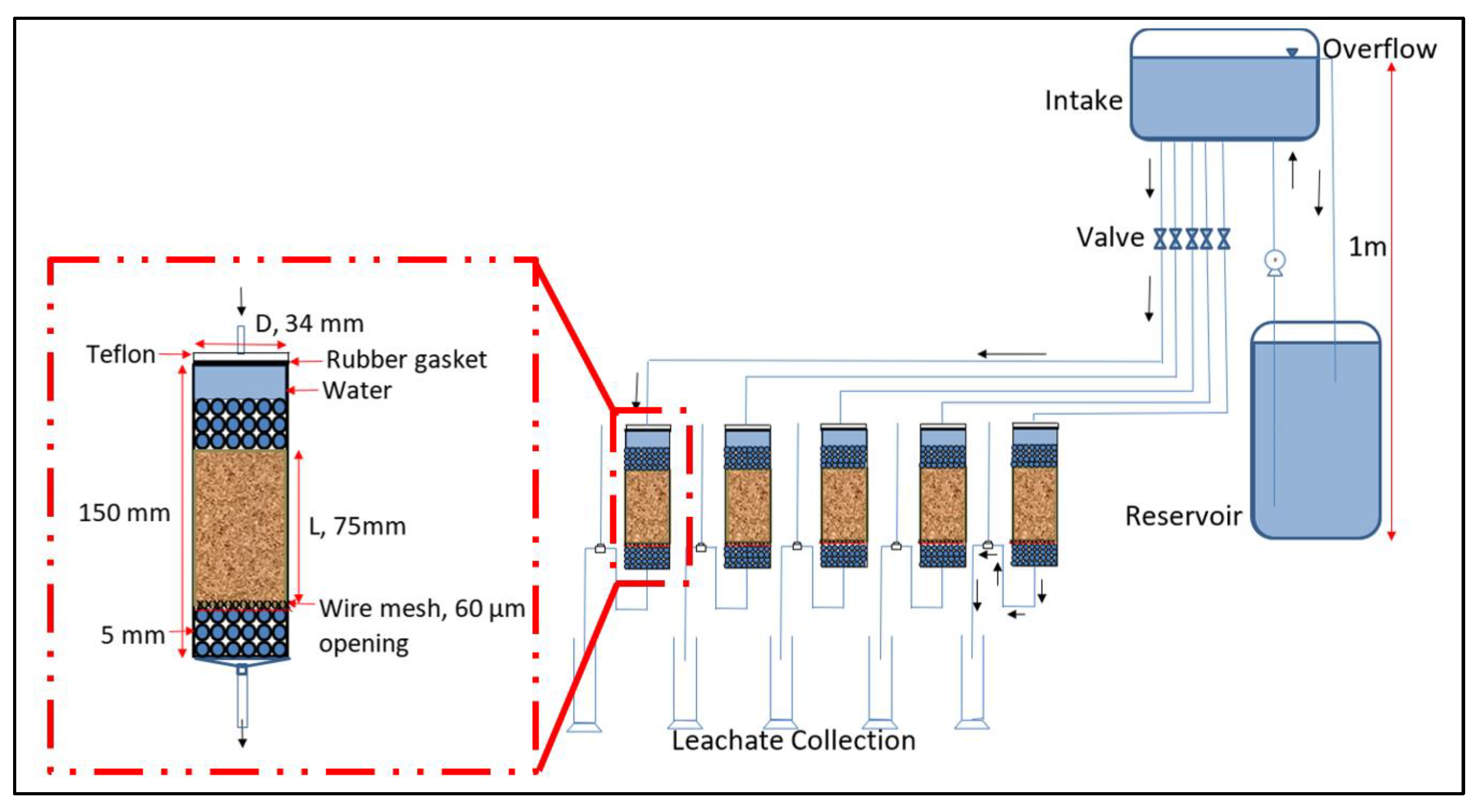

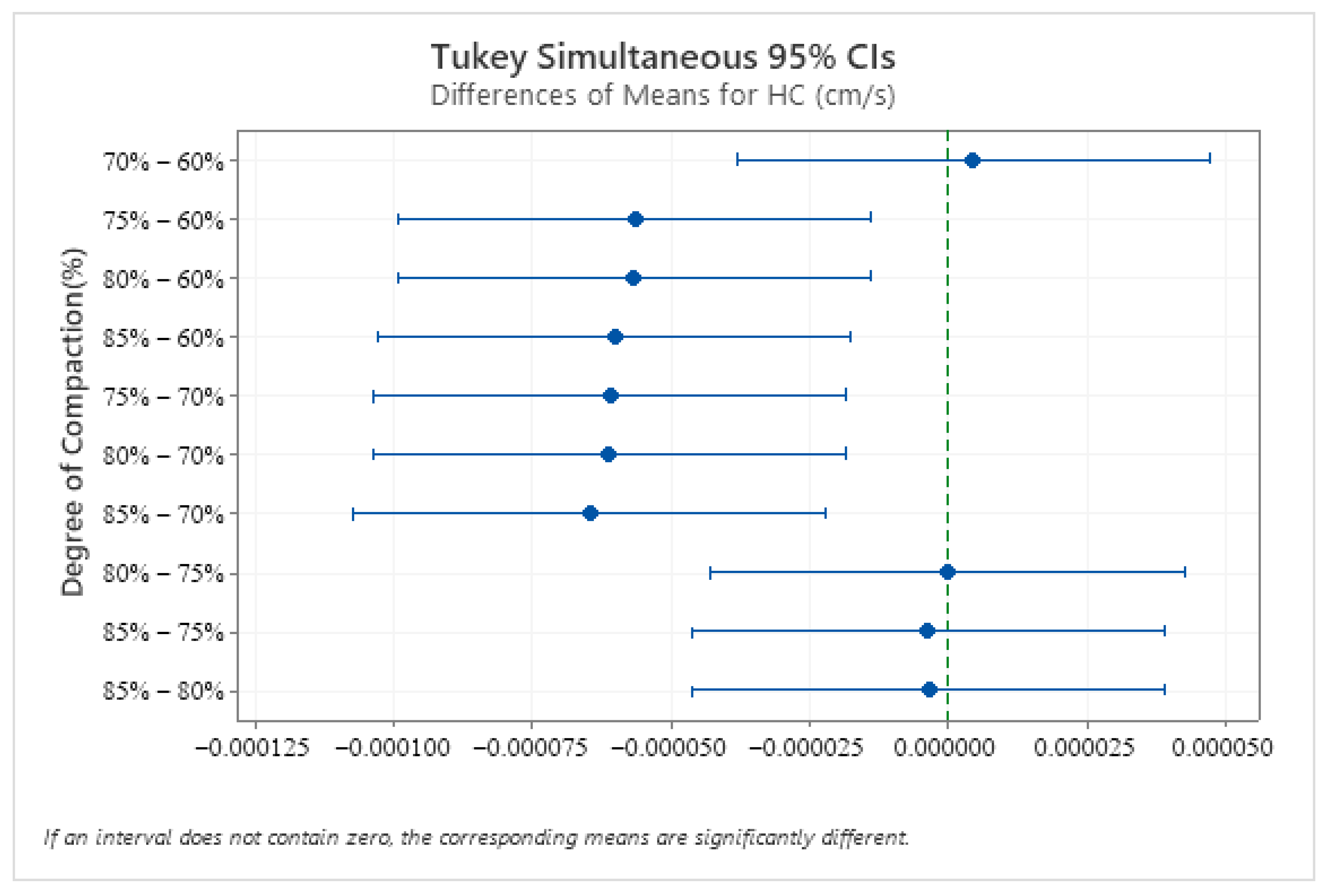
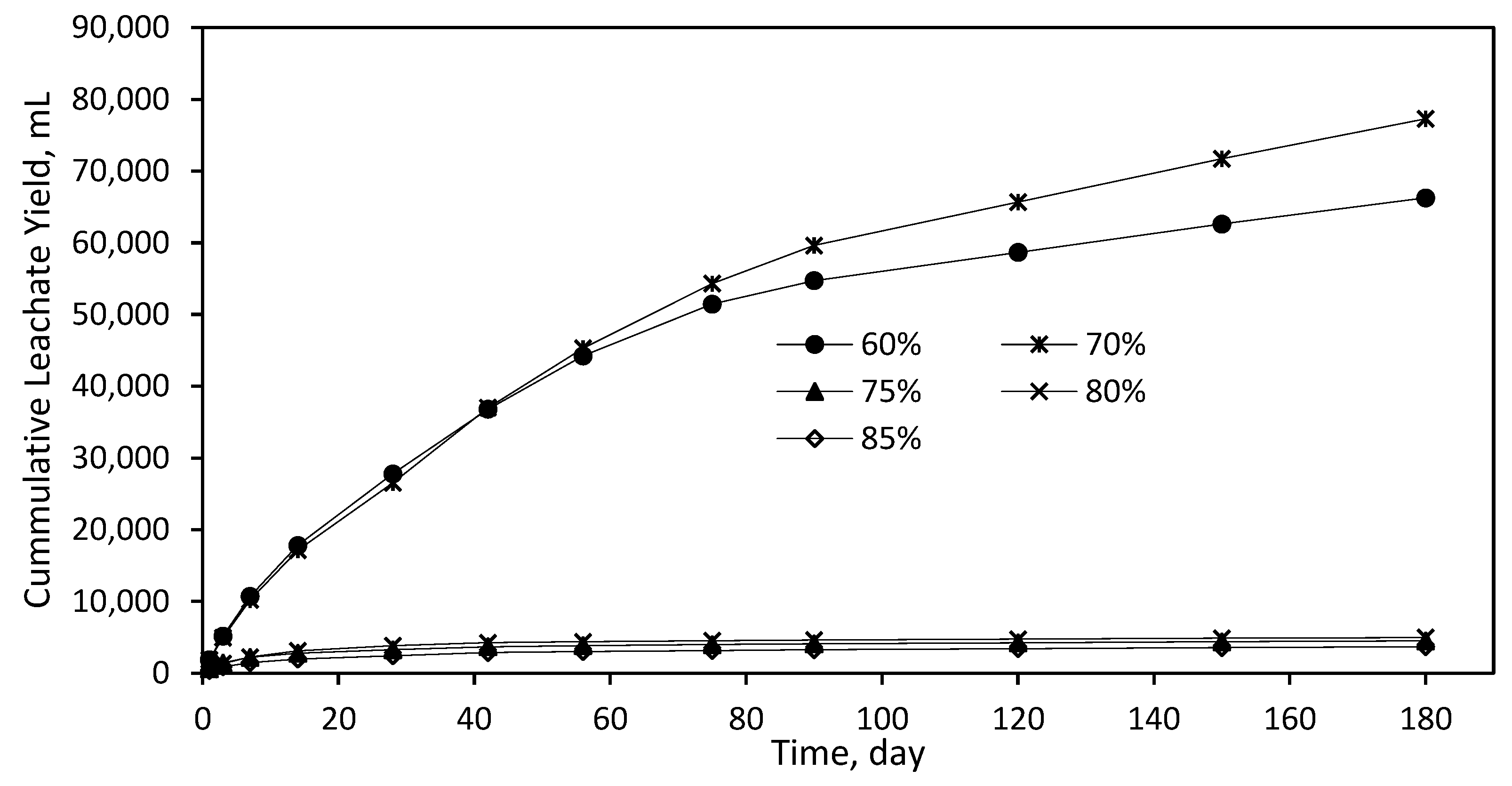
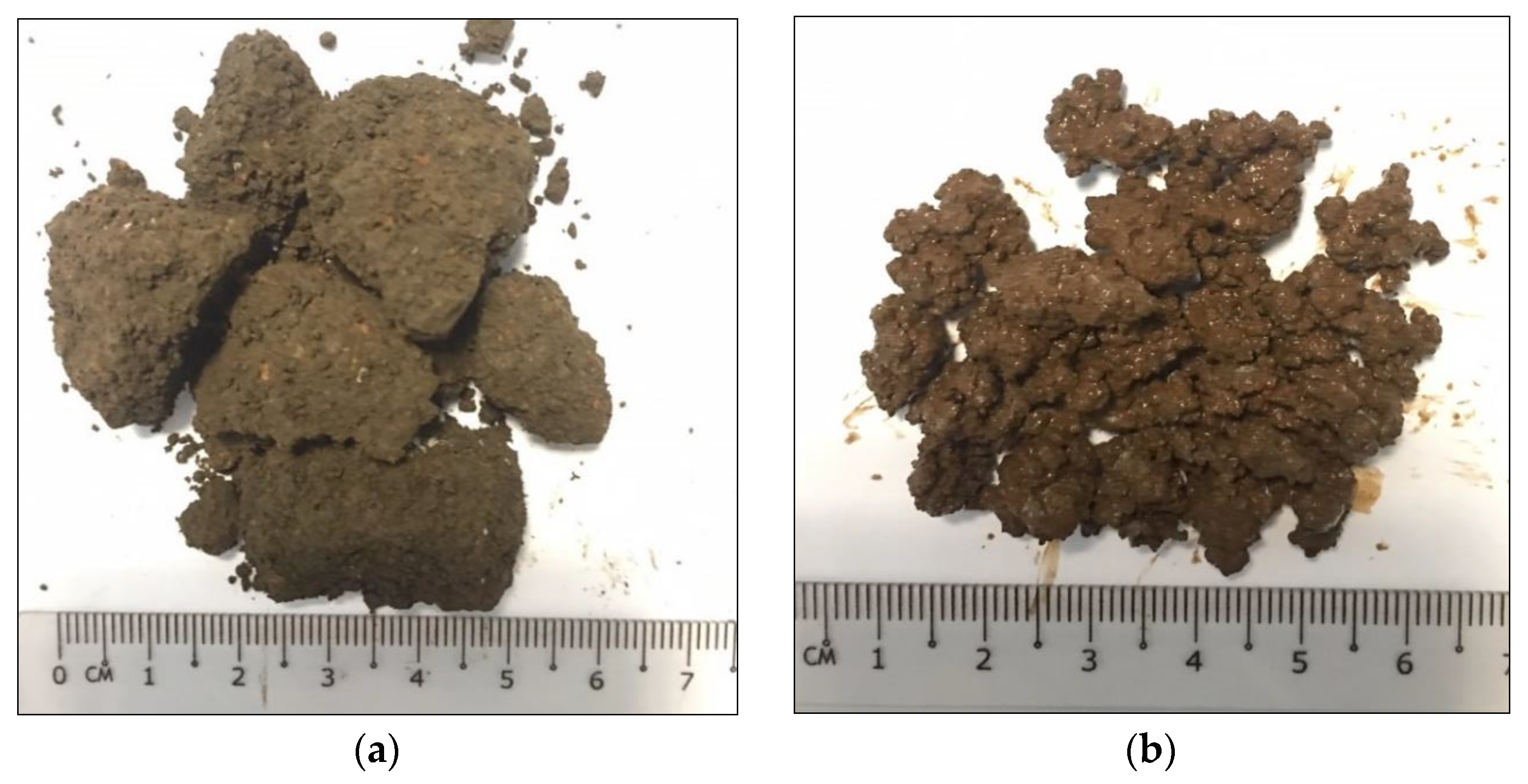
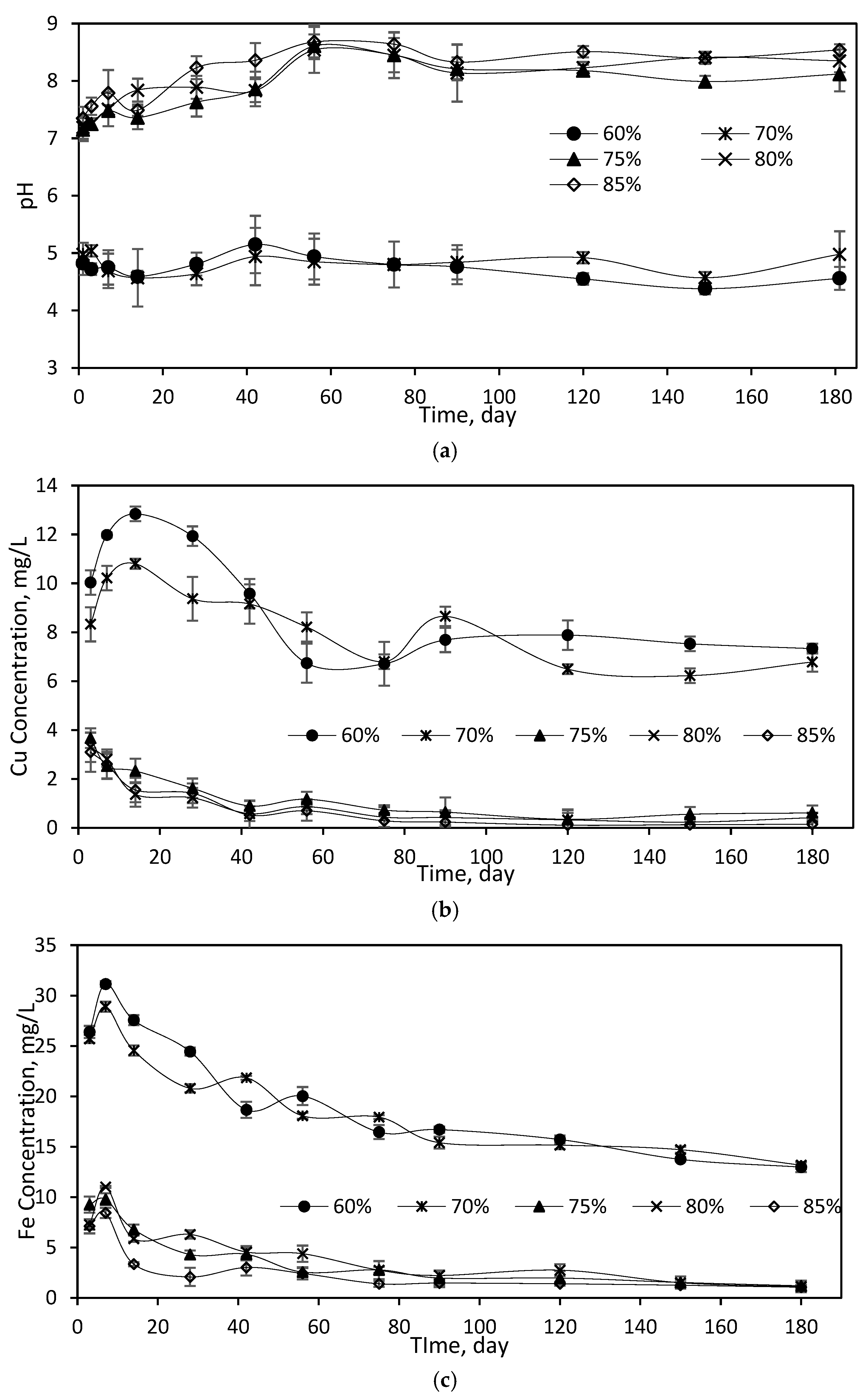
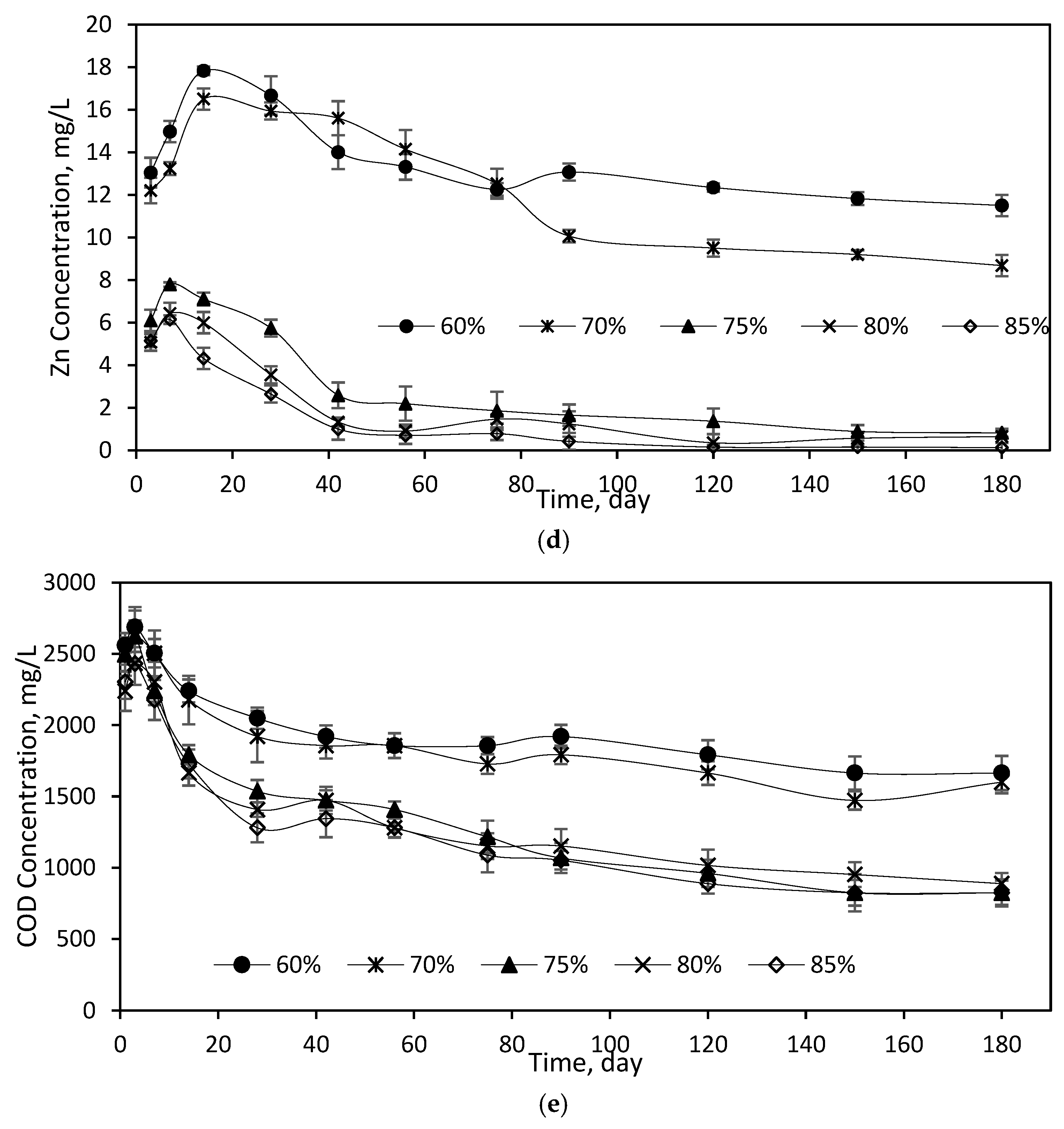
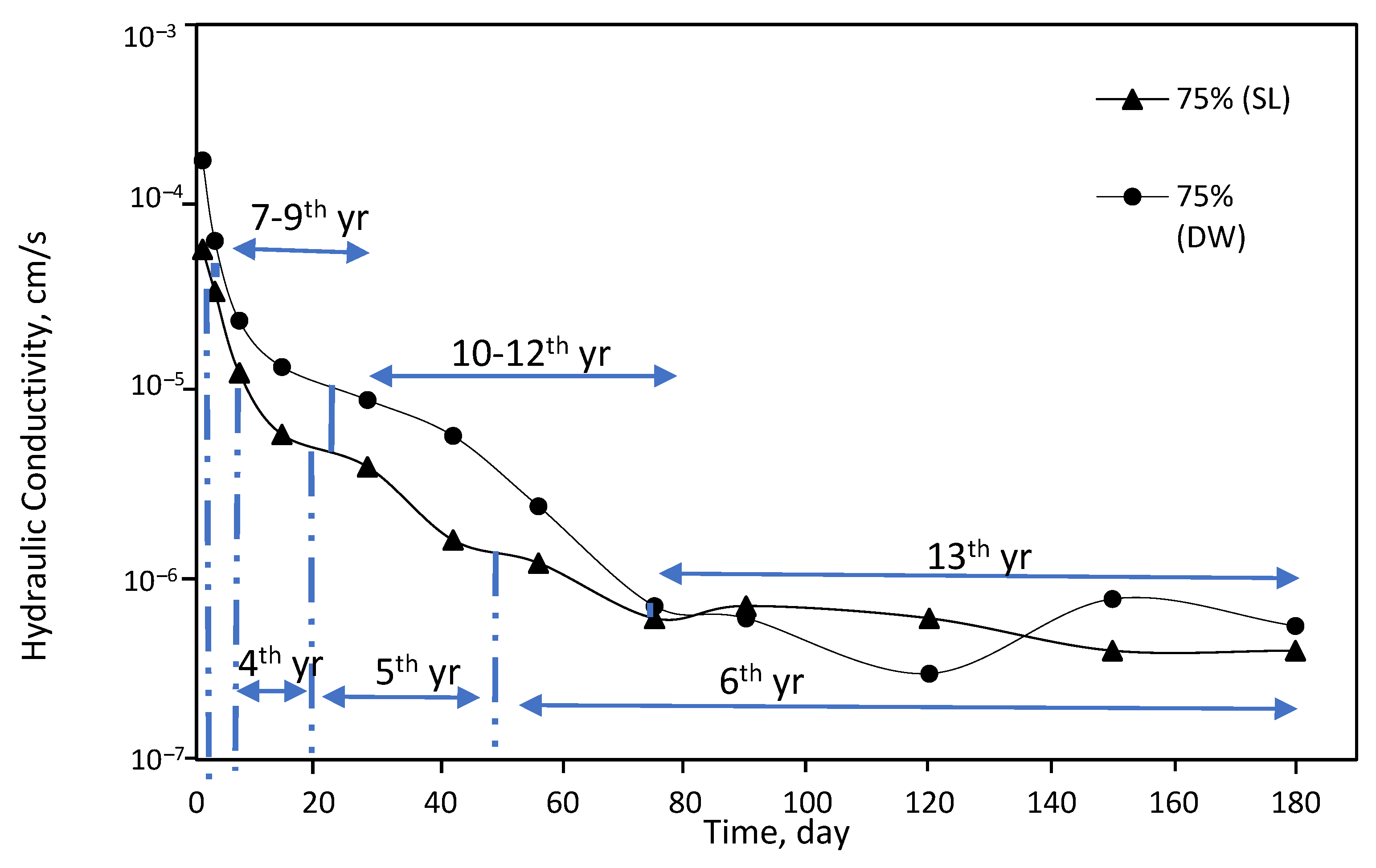
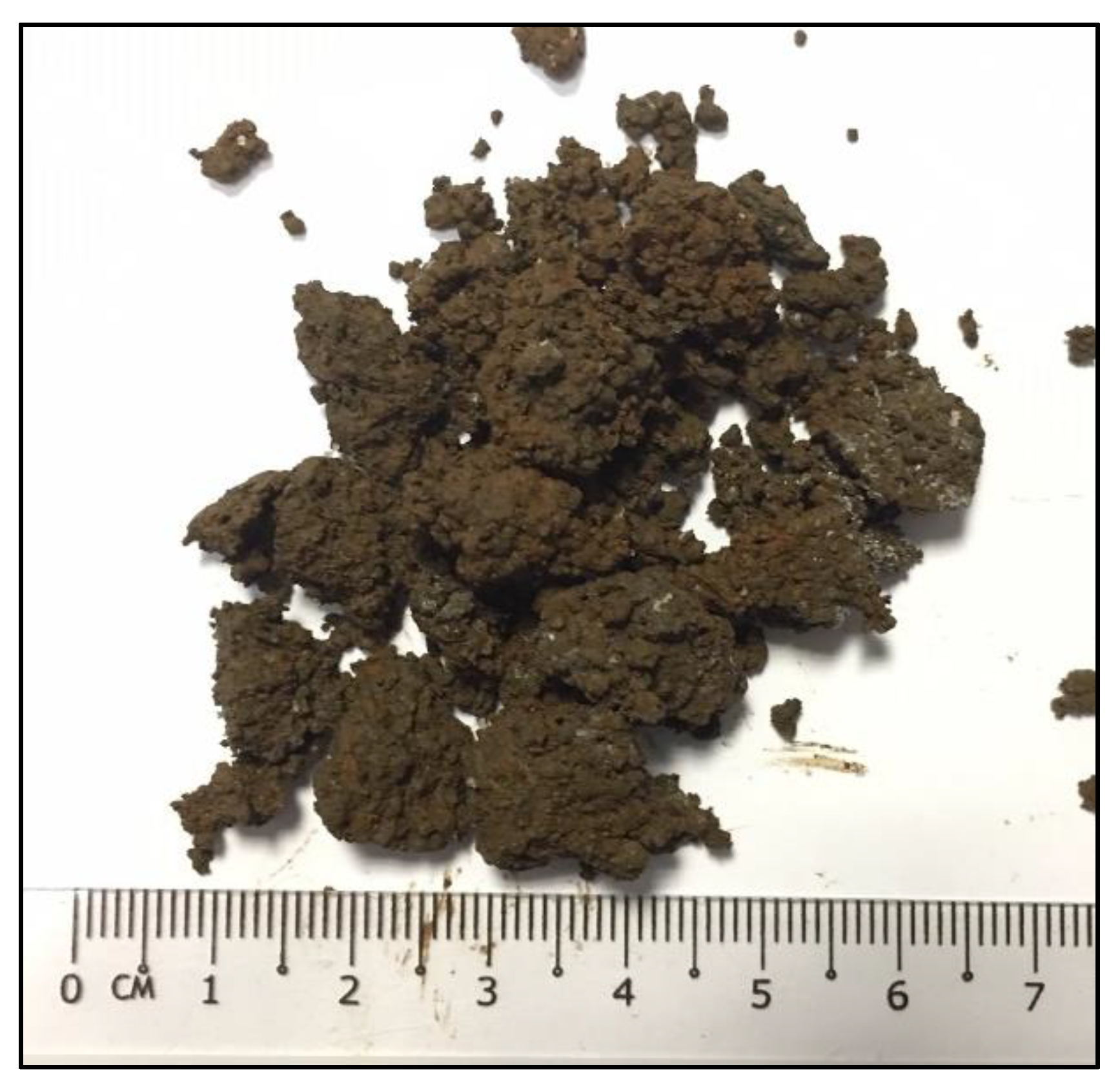
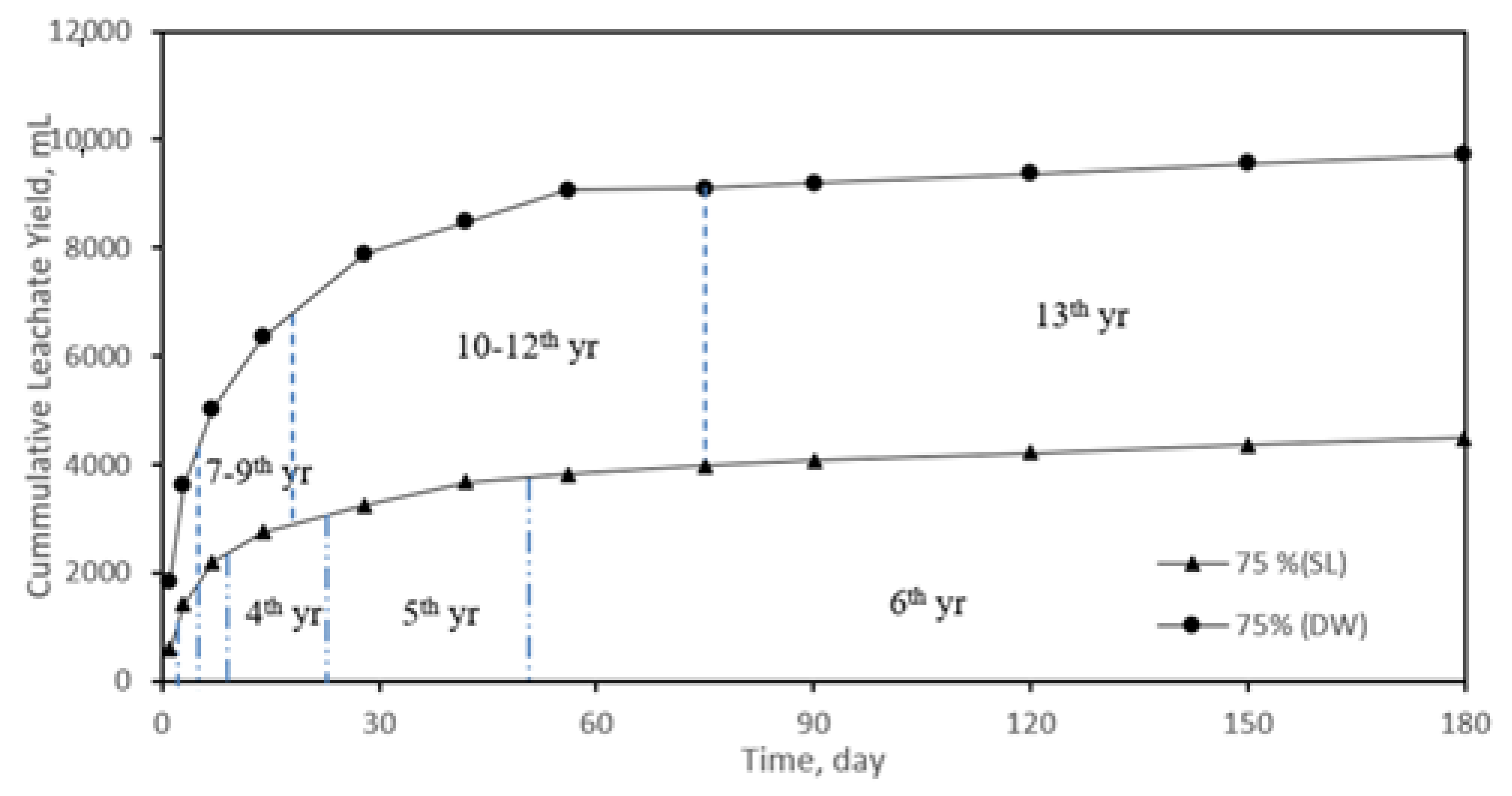
| Element | Chemical Product | Designed (mg/L) | Measured Feed Solution (mg/L) | Young Leachate (Acid Phase Formation) | |
|---|---|---|---|---|---|
| Stock Solution | Feed Solution | ||||
| pH | - | - | - | 4.83 | <6.5 |
| COD | Potassium Hydrogen Phthalate (C8H5KO4) | 50,000 | 5000 | 5210 | >10,000 |
| NH3-N | Ammonium Nitrate (NH4-NO3) | 10,000 | 1000 | 670 | <400 |
| Cu | Copper (II) Chloride Anhydrous (CuCl2) | 100 | 10 | 11.65 | >2 |
| Fe | Iron (III) Chloride Hexahydrate (FeCl3·6H2O) | 250 | 25 | 25.37 | >2 |
| Zn | Zinc Sulphate Heptahydrate (ZnSO4·7H2O) | 100 | 10 | 13.7 | >2 |
| Degree of Compaction (%) | N | Mean | Grouping |
|---|---|---|---|
| 70% | 12 | 0.0000711 | A |
| 60% | 12 | 0.0000667 | A |
| 75% | 12 | 0.0000102 | B |
| 80% | 12 | 0.0000102 | B |
| 85% | 12 | 0.0000067 | B |
| Parameter | Typical Raw Leachate [25] | Feed Solution | Degree of Compaction (%) | ||||
|---|---|---|---|---|---|---|---|
| 60 | 70 | 75 | 80 | 85 | |||
| Leachate Yield (mL) | - | - | 66,264 | 77,284 | 4499 | 4955 | 3677 |
| pH | 7.8–8.39 | 4.83 | 4.56 ± 0.2 | 4.98 ± 0.4 | 8.12 ± 0.3 | 8.35 ± 0.2 | 8.54 ± 0.1 |
| COD (mg/L) | 1929–4975 | 5210 | 1664 ± 88 | 1600 ± 78 | 824 ± 95 | 888 ± 75 | 824 ± 85 |
| Cu (mg/L) | 0.095–13 | 11.65 | 7.3 ± 0.4 | 6.8 ± 0.4 | 0.6 ± 0.2 | 0.4 ± 0.4 | 0.1 ± 0.3 |
| Fe (mg/L) | 3.61–23.2 | 25.4 | 13 ± 0.3 | 13.2 ± 0.2 | 1.2 ± 0.4 | 1.1 ± 0.4 | 1.1 ± 0.4 |
| Zn (mg/L) | 0.24–7.5 | 13.7 | 11.5 ± 0.4 | 8.7 ± 0.3 | 0.8 ± 0.4 | 0.6 ± 0.2 | 0.1 ± 0.4 |
Disclaimer/Publisher’s Note: The statements, opinions and data contained in all publications are solely those of the individual author(s) and contributor(s) and not of MDPI and/or the editor(s). MDPI and/or the editor(s) disclaim responsibility for any injury to people or property resulting from any ideas, methods, instructions or products referred to in the content. |
© 2023 by the authors. Licensee MDPI, Basel, Switzerland. This article is an open access article distributed under the terms and conditions of the Creative Commons Attribution (CC BY) license (https://creativecommons.org/licenses/by/4.0/).
Share and Cite
Rosli, N.A.; Abdul Aziz, H.; Kueh, A.B.H.; Lim, L.L.P.; Zawawi, M.H. Leaching Behaviour of Synthetic Leachate through a Sewage Sludge and Red Gypsum Composite as Intermediate Landfill Cover. Sustainability 2023, 15, 4229. https://doi.org/10.3390/su15054229
Rosli NA, Abdul Aziz H, Kueh ABH, Lim LLP, Zawawi MH. Leaching Behaviour of Synthetic Leachate through a Sewage Sludge and Red Gypsum Composite as Intermediate Landfill Cover. Sustainability. 2023; 15(5):4229. https://doi.org/10.3390/su15054229
Chicago/Turabian StyleRosli, Nor Azalina, Hamidi Abdul Aziz, Ahmad Beng Hong Kueh, Leonard Lik Pueh Lim, and Mohd Hafiz Zawawi. 2023. "Leaching Behaviour of Synthetic Leachate through a Sewage Sludge and Red Gypsum Composite as Intermediate Landfill Cover" Sustainability 15, no. 5: 4229. https://doi.org/10.3390/su15054229





